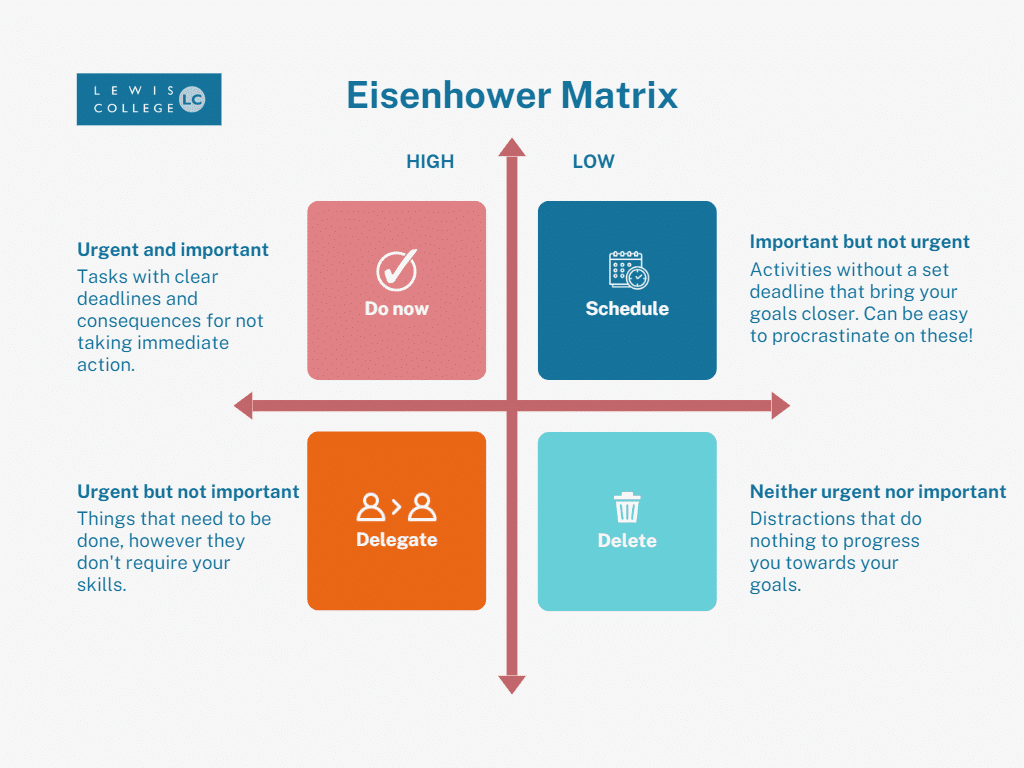As a personal assistant, your day-to-day work is full of tasks that require your attention, from answering emails to organising events. With so many things to do, it can be challenging to know where to start and how to prioritise effectively. One helpful tool for managing your workload is the Eisenhower Matrix. This matrix helps you categorise tasks based on their urgency and importance, so you can make more informed decisions about how to spend your time. Firstly, what is it and how can you use it?
What is the Eisenhower Matrix?

The Eisenhower Matrix is a decision-making tool that helps you categorise tasks into four quadrants based on their urgency and importance. The matrix was named after former US President Dwight D. Eisenhower, who was known for his ability to prioritise tasks effectively. He famously said: “I have two kinds of problems, the urgent and the important. The urgent are not important, and the important are never urgent.”
The four quadrants of the Matrix
- Urgent and Important: Tasks that are both urgent and important should be your top priority. These tasks require your immediate attention and have a significant impact on your work or personal life.
- Important but not Urgent: Tasks that are important but not urgent are things that need to be done but don’t require immediate attention. These tasks should be planned for and scheduled in advance to ensure that they get done.
- Urgent but not Important: Tasks that are urgent but not important are often distractions that can take up valuable time. Delegating or eliminating these tasks, if possible, will free up your time for more important work.
- Not Urgent and Not Important: Tasks that are not urgent and not important are time-wasters that should be avoided altogether.
How to Use the Eisenhower Matrix as a PA

Now that you understand the basics of the Eisenhower Matrix, here are some tips for using it to prioritise your tasks as a personal assistant:
Identify your tasks and place them in the appropriate quadrant.
Start by listing all of the tasks you need to complete, then place them in the appropriate quadrant based on their urgency and importance. This will give you a clear picture of what needs to be done and help you focus on the most important tasks.
Prioritise tasks in Quadrant 1.
Tasks in Quadrant 1 are your top priority and should be tackled first. Make a plan for how to complete these tasks quickly and efficiently to avoid any negative consequences. Some examples could be:
- Responding to urgent emails or phone calls from clients or colleagues
- Meeting important deadlines for projects or reports
- Handling urgent issues or crises that require immediate attention
Schedule tasks in Quadrant 2.
Tasks in Quadrant 2 are important but not urgent. Make sure to schedule time for these tasks to ensure that they get done, but don’t let them take up too much of your time. A few examples of these are:
- Developing long-term strategies or plans for the company
- Conducting research to inform future business decisions
- Building relationships with key stakeholders or clients
Delegate or eliminate tasks in Quadrants 3 and 4.
Tasks in Quadrants 3 and 4 are either urgent or not important, so they should be delegated or eliminated whenever possible. This will free up your time for more important work. Some examples of Q3 and 4:
- Sorting and responding to non-urgent emails or messages
- Running errands or completing tasks that are not directly related to business goals
- Attending meetings that are not essential to your role or the company’s objectives
- Checking personal emails during work hours
- Engaging in unproductive or time-wasting activities (we’re looking at you, social media!)
- Completing tasks that are not necessary or have no real value to the company
To conclude
Well, there you have it! As a personal assistant, you now have a powerful tool to prioritise your never-ending to-do list. With the Eisenhower Matrix, you can tackle your tasks with confidence, knowing that you’re focusing on the most important and urgent ones first. Remember to take a step back and assess your workload regularly. Don’t be afraid to delegate or say no when necessary. And most importantly, don’t forget to celebrate your accomplishments, no matter how big or small! Keep hustling and go crush those tasks like the boss you are!


3 responses
I have just enrolled in the Executive PA Course. I find the Eisenhower Matrix relevant to my specific roles and responsibilities as a PA to Directors of IT at. Bournemouth University. Fantastic information. Thank you
I used this as a detailed answer, giving examples when used in past jobs, during interviews when asked how I handle workloads, managing my time, prioritising, working within a team, problem solving, etc. I find it helps to journalise all the examples when used, (not just in the workplace but outside as well), so they are easily remembered during interviews, appraisals….asking for a pay rise!
I am a PA Certificate student and this is a great example of all the clearly explained, helpful and practical tools the course provides. Thank you Lewis College for providing such a wonderful course!